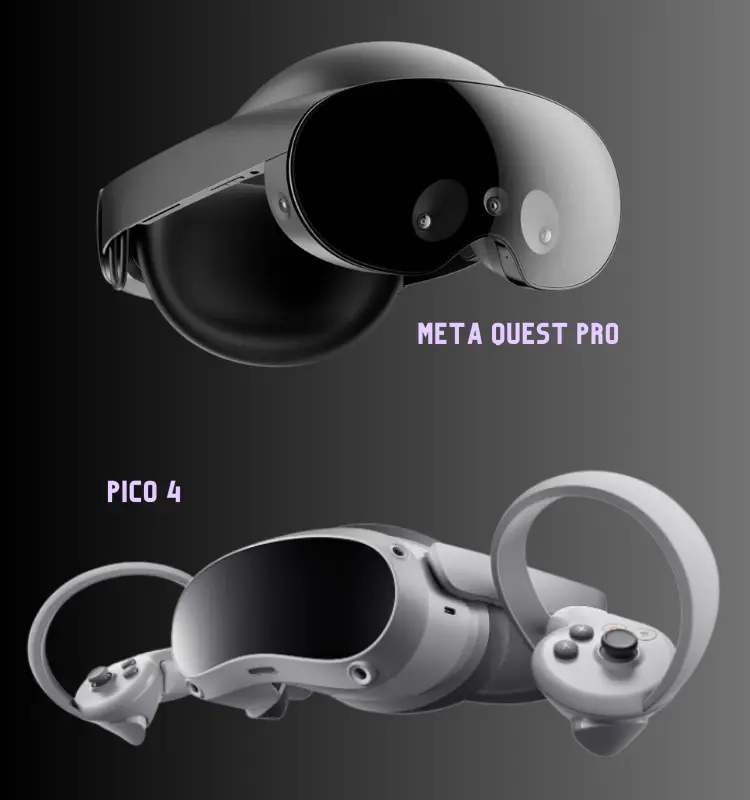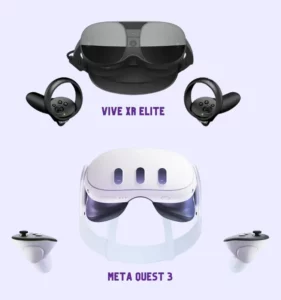It’s hard to believe, but the latest generation of VR headsets has arrived, bringing with it some impressive upgrades. There has been a lot of talk about two new virtual reality headsets, the Pico 4 and the Meta Quest Pro. The former has just made its debut, while the latter has been anticipated for some time due to various leaks.
Now that we have both headsets at our disposal, we can evaluate them side by side. Those on the fence between the Quest Pro and the Pico 4 should read on. Extended reality’s advantages are accessible to everyone. However, attention is beginning to move away from the entertainment and gaming industries as the principal users of augmented and virtual reality innovations. In recent years, there has been a meteoric rise in the number of businesses implementing XR solutions to increase teamwork, productivity, and training.
Let us now have a detailed comparison between Meta Quest Pro and Pico 4:


Comparison Table: Pico Vs Quest Pro
| Specs | Pico 4 | Quest Pro |
| Screen Type | LCD | 2 X LED Backlit LCD |
| Resolution | 2160 x 2160 per eye | 1800 x 1920 per eye |
| Lens Type | Pancake | Pancake |
| Refresh Rate | 90Hz | 75Hz, 90Hz |
| Field of View | 105 degrees | 106 degrees |
| RAM | 8GB | 12GB |
| Processor | Snapdragon XR2 Gen 1 | Snapdragon XR2+ Gen 1 |
| Sensors | Accelerometer, Gyroscope, Vibration Sensor | Accelerometer, Gyroscope |
| Tracking | 4 Cameras, 6DOF Inside out tracking | 16 Cameras, 6DOF Inside out tracking, face + eye tracking |
| Weight | 586g | 722g |
| Requirements | None | None |
| Audio | Integrated 360 surrounding stereo speakers, supporting 3D spatial sound, Dual Microphone | Built Microphone, Stero Headphone Jack |
| Controllers | 2 x 6DoF broadband haptic motion controllers | Quest 2 ProControllers |
Let’s read! Apple Vision Pro vs Quest 3
Releasing Date:
Pico has just introduced the standalone VR headset Pico 4, clearly aiming to compete with Meta Quest Pro in both price and content. There are currently no plans to release the headset in the United States, but it will be available in Europe and select Asian nations beginning in October.
Pico has been producing VR headsets for a while, but up until now, the company has focused on the business sector. More recently, ByteDance purchased the company, and early this year, it made its first real foray into the consumer VR field with the release of the Pico Neo 3 Link, a standalone VR headset with the ability to link to a desktop for PC VR gaming.
With the Pico 4, the business intends to gain ground on Meta’s Quest Pro headset in pricing and features while also positioning itself to compete with Meta on content. The Pico 4 is almost ready for release.
The virtual reality headset Pico 4 has achieved early success on SteamVR as a standalone product. Quest Pro, on the other hand, blends in seamlessly with your desktop.
The release of Pico 4 on October 18, 2022, in 13 European nations, Japan, and South Korea marked the arrival of the first real opponent for Meta Quest 2 (review). Pico 4 is yet to launch in the United States, the industry’s main market.
The gadget works best when used independently, much like Meta Quest 2. However, you can use them as SteamVR glasses because they can connect wirelessly or by wire to a computer.

Comparing The Mixed Reality
The Meta Quest Pro and the Pico 4 Enterprise appear to share several similarities. Both the “prosumer” and business markets are crucial to the growth of the items. Pancake lenses and an ergonomic design make these glasses comfortable to wear all day.
Features like live streaming and a kiosk mode that allows customers to activate a specific app with a single tap are available on the Pico 4 Enterprise for usage in commercial settings. Users can access a broad enterprise software store, manage their devices remotely, and add new features through automatic software updates.
The Meta Quest Pro is a “prosumer” product since it has both business and consumer applications. The Meta Quest Pro is compatible with Microsoft Office and Teams in addition to its own set of introductory software. Adobe Acrobat is among the supported software.

Comparison based on Specs Quality and The Hardware, Software and Performance
The CPU and chipset technologies are where the Quest Pro and Pico 4 Enterprise diverge. The Quest Pro’s Snapdragon XR2+ processor is identical to the Snapdragon XR2 found in the Pico Neo 3 Pro and HTC Vive Focus 3. This processor has more RAM and uses less power than its predecessor, so it can perform at faster rates without overheating.
Even though the Qualcomm Snapdragon XR2 used in the Pico 4 Enterprise has significantly less processing capability than its predecessor, it still boasts an impressive 8GB of RAM. Users may expect a great deal of processing speed and functionality from both options.
Pico and Meta both opted for “pancake” optics to lighten the load of their respective gadgets. Automatic interpupillary distance (IPD) adjustment features and similar fields of vision are also present in both tools for optimal viewing clarity.
While the Pico 4 Pro has a standard LCD lens, the Meta Quest Pro’s QLED lenses with 500 local dimming zones provide significantly more contrast. The Pico 4 Enterprise, on the other hand, boasts more pixels per eye than the Meta Quest Pro, suggesting a potentially more lifelike 4k experience.
Pico 4 requires a wireless WiFi 6 connection dongle to work with SteamVR and its library of more than 4000 games, which can be problematic for some users. This is because the Pico 4 lacks a DisplayPort input. However, the Pico Neo 3 Link and the Quest 2 are still viable choices if wired streaming is a priority. The Pico 4 should easily be able to transmit 4K video at 90 frames per second thanks to its WiFi 6 capabilities.
Uncertainty remains regarding the Quest Pro’s streaming choices, but the Quest Link’s popularity suggests both wired and wireless connections will be available. Which will have the same level of quality as the Quest pro headphones
When comparing the Pico 4 Enterprise to the Meta Quest Pro, the former offers a more comfortable ergonomic experience due to its reduced weight. While the Meta Quest 2 has improved in certain ways, the Meta gadget is still preferred for its ease of use and lightweight design. Each headset also has a dial that can be turned to customize the fit to the user’s skull.
The Quest Pro, on the other hand, has a halo-style strap with a secondary adjustment knob to allow wearers to fine-tune the distance between the lenses and their eyes. This means the Quest Pro could provide a slightly more relaxed experience for its users.
The Pico 4 Enterprise is less expensive than the Meta Quest Pro, despite both of them having high-quality stereo sound systems. The system’s flexibility allows users to make use of all it has to offer. The Meta gadget has two earphone jacks, so you can plug in your headphones or earbuds and listen on the go.
Comparing the Pico 4 Enterprise and the Meta Quest Pro, we can see that the latter uses five infrared cameras to follow the user’s face and eyes, while the former only uses three. Foveated rendering, a feature of the Meta Quest Pro, might be useful for controlling data transmission rates as well.
While the Meta has four, the Pico only has one RGB passthrough camera. High colour passthrough is essential for both, as it allows users more freedom in creating engaging mixed-reality settings.
Incorporating one of the Quest Touch Pro’s three SLAM cameras and the Quest’s pre-installed Snapdragon CPUs makes it much easier for the controllers to send their location to the headset. It’s possible that users can achieve much greater precision than they could with conventional controls. Players may position their hands closer together without worrying about missing a shot thanks to the Pico controller’s hit-detection shield and spinning arc column.
Dig your knowledge! Meta Quest Pro Vs Pico 4
Comparison on Design
The incorporation of Pancake lenses has resulted in a significant redesign of the latest headsets from Pico and Meta. The Quest Pro and Pico 4 headsets are only a third as thick as their predecessors, the Pico Neo 3 Link and Oculus Quest 2, because of advancements in lens technology.
When it comes to positioning the battery, Pico was an early adopter by putting theirs in the back of the head strap. As with previous models, the Pico 4 features excellent weight distribution, making it easy to use for long periods. The Quest Pro appears to have taken inspiration from this idea by incorporating the battery inside the head strap. However, it’s worth noting that Microsoft already employed this concept with the Hololens 2 as well.
A fit wheel on the back of the Quest Pro and Pico 4 allows the user to customize the size of the gadget. You can adjust the headset’s fit while it’s on your head, which saves time and effort. In contrast to the Quest Pro, the Pico 4 features an adjustable velcro strap at the top.
Pico opted for a predominantly white design with a glossy polished black front panel, which is the most noticeable visual distinction. The Meta, on the other hand, has opted for a more subdued colour scheme that recalls the original Oculus Rift S and Oculus Quest.
The improved displays and even weight distribution make both devices seem like they would be easy to wear, with the top strap of the Pico 4 possibly allowing for a somewhat more snug fit. However, Pico 4 is more bearable for extended periods because of its significantly lower weight of 295 grams compared to Meta Quest Pro’s 722 grams.
Related Post: Meta Quest 2 vs HTC Vive
Comparison of batteries
The Pico 4 has a 5.300 mAh battery and supports 20W rapid charging through its USB-C connector. The Quest 2’s battery capacity is 3,640 mAH, which is significantly lower than the original. Meta doesn’t provide a charging time, but the included 10W USB-C power adapter will fully charge the headset within 2.5 hours of being dead.
Comparison on price
The Quest Pro is more expensive than the Pico 4. The cost is a major distinction between the gadgets. There are two storage capacities available for the Pico 4, 128 GB for 429 euros and 256 GB for 499 euros. Businesses may expect to pay 1800 Euros for the 256 GB Quest Pro. This considerable variation reflects the different target markets for the Quest Pro and HTC/Varjo headsets.
The Quest Pro costs more because of its superior mixed-reality features, high-fidelity tracking, and ground-breaking body-tracking technologies.
Final Words
The Pico 4 Enterprise and the Meta Quest Pro have many similarities. The Pico 4 Enterprise is one of the most potent tools soon to be on the market, thanks to its astoundingly high degree of visual clarity and incredible quantity of processing power. In addition to being lighter and more comfortable than the Quest Pro, this device also has a longer potential battery life.
On the other hand, the Meta Quest Pro may offer superior colour passthrough, enhanced tracking capabilities, and a broader selection of enterprise-ready app connectors.
Read More: Meta Quest 3 Vs Vive XR Elite






